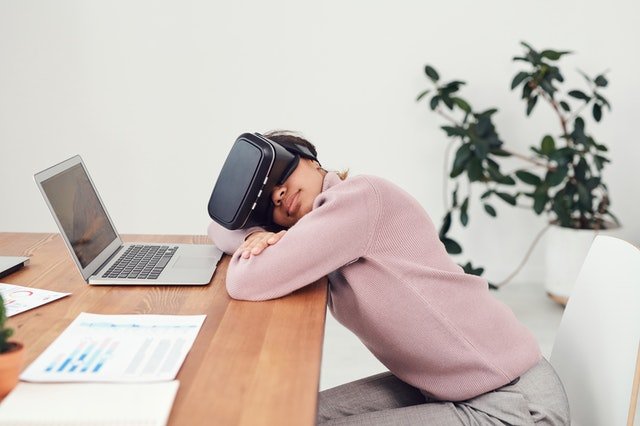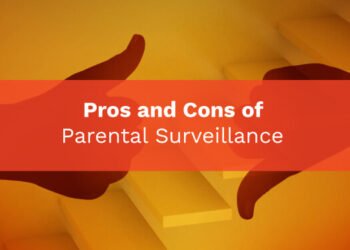Cybersickness can be said as the sickness or discomfort that arises with interaction with technology. It could be shutting off the real world completely and adopting virtual reality. Cyber sickness can result from digital effects from augmented reality. Some experience motion sickness just while going across the screens.
Cybersickness is the feeling of being unwell occurring from the excess use of computers or electronic devices that have screens. Cell Phones and personal computers have become so important that we spend a lot of time with human-made gadgets. The obsession starts with straining of eyes.
It is a condition that takes place when you encounter discomfort while using devices and immerse yourself in different technologies. It includes entering the world of illusion fabricated with texts, sounds, digital entities. Most humans receive entertainment. Some humans react in an opposite way that leads to cybersickness. So what exactly happens?

What Exactly Happens in Cybersickness?
Cybersickness refers to the symptoms that a user experiences in the duration of exposure to the engulfing environment. Some experience symptoms after an interaction with the environment. The depth of sickness is related to the amount of time spent with technology. If your kid spends more time, then the symptoms are severe.
Your kids start the day with an alarm on the cellphone, and mostly the first thing that children look at is the screen of the mobile. They keep checking the same screen, again and again, several times a day. This excess affinity to the screen and various technologies surely has some effect on humans.
When your kid is revealed to such surroundings, their senses are stimulated. The senses are stimulated unusually, resulting in some psychological response. When your kid receives exposure to several screens simultaneously, the senses send opposite signals to the brain and the disorientation is vivid in the physical actions.
Why Is It Important To Know About Cybersickness?
Most often, symptoms like nausea, headache, or dizziness are symptoms of cybersickness come and go. Your kids may experience such symptoms. They occur one day and disappear the other. The main reason behind this could be something else.
If your kid is too busy in the virtual world, then it is time for you to check upon him. Too much involvement leads to uneasiness and can affect your child if they do not limit the use of screens. While you take these symptoms lightly, these may be causing trouble for your kids.
Types Of Realities That Lead To Cybersickness:
Augmented Reality Leading To Cybersickness:
Firstly, while your kid is busy playing Pokemon Go live, your son uses a camera for digital effect supported as augmented reality. Your daughter is live on snap chat using the same mechanism.
Augmented reality consists of real-life scenes with extra effects from sounds, images, texts that enhance the view digitally. It can result in psychological maladaptation in a few users. Also, this technology can cause oculomotor discomfort, disorientation, and nausea also termed cybersickness.
Virtual Reality Leading To VR Sickness Or Cybersickness:
In virtual reality, the whole world is shut in front of the viewers, and it feels as if they have entered a different world by using devices like Oculus Rift, HTC Vive, PlayStation VR, and other VR headsets.
The kids sometimes lose the sense of presence in the virtual world. Some experience bodily discomfort. Some VR games require control and navigation, while others are sexual.

Vr can produce malaise after revealing to the surrounding. Cybersickness is prevalent in Visually Induced Motion Sickness(VIMS) and Simulator Sickness (SS). VISM occurs due to the visual motion as cognized by your kid. SS includes the discomfort obtained from motion in simulators like a vehicle simulator that are present in VR.
Mixed Reality And Extended Reality Leading To Cybersickness:
Mixed reality includes the combination of Virtual Reality and Augmented Reality. When kids make use of such technology, it may result in cybersickness. Extended reality is the mixture of Augmented Reality, Virtual Reality, and Mixed Reality. All these results in cybersickness.
Motion Sickness And Cybersickness:
Motion sickness and cybersickness give out the same symptoms. In motion senses what your kid views, knows, and senses do not tally. The sensory mismatch is like showing a different environment but explaining something else leads to motion sickness.
Cybersickness lies under motion sickness. In motion sickness, there is a disassociation between the eyes and the vestibular system. It includes dizziness, nausea, sweating, and fatigue.
Causes Of Cybersickness
The major cause of cybersickness is the excess use of devices. Some mechanisms of the body are affected. That includes:
Proprioception:
This system includes the nervous system and sensory receptors. We have sensory receptors in our hands, skin, muscles. When we move our hands, the brain knows the object’s weight and decides to lift it or not lift it.
In cybersickness, the proprioception responds, telling the brain that everything is alright. Sensory organs like the eyes, on the other hand, signal the brain that there is a lot to process in the visual. The brain gets confused and shows symptoms of cybersickness like nausea.
Vestibular System:
The vestibular system includes the balance of the inner ear. The vestibular system’s work is to give information about the position of the body to the brain. When there are internal or external forces, then a response sent.
In cybersickness, the vestibular system sends information to the brain signaling everything is alright, but the sensory organs send something else. Mixed signals result in the brain causing symptoms of cybersickness.
Sensory Organs:
The sensory organs like the eyes react to the visuals or screen immediately. The flashy display or fast scrolling lets the eyes send a signal to the brain that there is a lot to process.
When the proprioception vestibular signals do not tally with the signal sent by sensory organs, the brain is puzzled, and that is observed as symptoms of cybersickness by us.
Symptoms Of Cybersickness:
Some people experience cybersickness as if the screens invocate the symptoms. The moment they spend some time with the screen or devices, they start experiencing symptoms. Some symptoms of cybersickness are:
Dizziness:
When your kid spends too much time on the screen, then it can lead to dizziness. A slight headache sometimes follows dizziness. Headache causes discomfort, and it is advisable to ask your kid to stop the work for some time and rest in dizziness.
Headache:

Excess watching of the monitor can lead to a headache. Improper posture sometimes leads to straining of the neck and shoulders. It is advisable to maintain correct posture for kids who spend maximum time on the computer.
Strained Eyes:
When eyes are fixed to electronic devices, they get tired and need rest. Eyes get irritated and remain dry, for which eye drops are recommended.
Nausea:
Nausea refers to the tendency to vomit. Such discomfort results due to cybersickness. Nausea occurs due to some unpleasant smell.
Sweating And Flushing:
Another symptom of cybersickness is sweating and flushing. Sweating can occur due to a change in the temperature of the body and may result in uneasiness. Flushing refers to the warming of the body and becoming red and hot.
Tips To Prevent Cybersickness:
The first thing you can do is make your kids aware of cybersickness. With modern devices the way of parenting also needs amendment. Once kids know of cybersickness, help them prevent it before happening. Some tips to prevent cybersickness are:
- Limit the usage time of screen or technology requiring a monitor. You can limit the time to 1-2 hours for your kid. Else they demand a lot of time playing games or doing other activities using the screen.
- Scroll the pages slowly such that one thing is observed at a time. Kids look into the pages of electronic documents like they were books. Ask them to scroll it slowly such that their eyes catch a proper glimpse and blurry vision is avoidable.
- Sit in a fresh room where there is an exchange of fresh air and no bad smell. Often, kids do not remember closed ventilators and spend the whole day in a room without fresh air. Staying at a place can make them feel stuffy, and the electronic devices keep them stale. The whole family can have active time outside.
- Be in a calm state before using the screen. If your child feels uneasy in front of screens, then help them calm down. The use of computers in school is mandatory, so help your kid relax.
- Look at other objects from time to time while using the screen. Children at times fix their eyes on the screen without blinking. Looking constantly at the screen can cause dizziness. Ask your kids to take their sight away from the screen and look at other objects from time to time.
- Make use of books rather than e-books. Some schools and colleges provide electronic books. Encourage your child to visit libraries and read paper books. Paper books for children will reduce the risk of cybersickness.
- Try to limit digital use for jotting down points. Use a paper notebook instead. Tech devices replace notebooks and papers. The use of devices like a tab or iPad for writing, sketching is common among students. With this, a lot of stress occurs in their eyes.
- Listen to audio material rather than using video materials as sources for research. Educational purpose demanding for electronic devices and access to the internet has increased the number of patients with cybersickness. If possible, ask your child to listen to podcasts or audio rather than long, daunting videos for study purposes and make use of Alexa for simple activities.
- Do not read from the screen in a moving vehicle. Kids have a habit of reading novels or stories during travel via Kindle. Tell your kid to stop reading in a moving vehicle immediately. Reading in a moving vehicle causes nausea. Nausea is one of the symptoms of cybersickness.
- Stay away from bright displays or pop-ups. The internet is full of content with a bright color combination. Pop-ups are inevitable on many sites. Tell your kid to avoid such encounters as they are for business purposes and strain eyes.
- Avoid VR games and play games that involve nature. There are varieties of video games available. Your kid can ask you to buy the latest ones. Games, including VR headsets and other devices, need time limitations to play. Kids hang out and can play games non-stop the whole day. This habit needs amendment.
- Take regular breaks from excess use of the screens during lectures or presentations. Ask your child to take breaks from the long sessions of presentations. Stretching is important from time to time amid the sessions.
- If your kid is learning from home, ask them to change their postures and position from a studying place. Changing places from one room to another is refreshing. The change in posture ensures that there is proper blood circulation throughout the body. Moving from one place to another and exercises reduces stiffness.
- Chewing gums is also one of the ways to keep jaws active. In cybersickness, the brain is confused between the signals sent by sensory organs and the vestibular system. Chewing gum can help your kid’s brain solve the conflict problem, and no symptoms of cybersickness occur.
- Deeper breaths help to ease the mind. Deep breaths and breathing exercises help enough oxygen to reach the brain. In this way, the brain stays active, and the risk of cybersickness reduces.
Tips To Overcome Motion Sickness That Includes Cyber Sickness
There are some natural ways to reduce motion sickness that can help in treating cybersickness too:
Acupressure Points In Body:
There are certain pressure points in the body. When pressure is applied, they work to reduce tension or pain. Pericardium 6 on the wrist is one of such points. You can teach your kid to press that part of the wrist for 5-10 minutes. Both wrists require pressure.
The point lies below your kid’s index finger in between tendons and the wrist. You can place your index, middle and ring finger on your kid’s pressure point and teach them to do so on their right and left hands.
Aromatherapy:
The smell of essential oils helps to relieve stress. The oils include lavender, lemongrass, ginger, lemon. Sniffing such oil drops helps to calm you down and relax. The oils have a pleasant odor and help to control nausea. Essential oils keep you fresh and lively. You can massage with such oils in areas where you have stiffness like the neck, shoulders.
Chamomile Tea:
This tea helps to reduce acid and keeps the stomach in perfect shape. It reduces the irritation and discomfort in the digestive tract. If your kid has cybersickness, then sipping chamomile tea will do good.
Kids can sip the tea while working with screens or using the technologies. Intake of chamomile tea will help in easing the symptoms of cybersickness.
Cybersickness Spectacles:
These are also called motion sickness spectacles. More research is required on this product. These glasses have two lenses at the front. The rims have blue liquid-filled till half. The liquid helps the user feel what they see.
Seeing A Doctor:
If the above-mentioned natural remedies do not work, then it is time to take your kid to the doctor. The doctor can advise some medicines. It is better to sort this matter at home. The main thing is that the symptoms should fade away after stopping the use of devices.
If the symptoms worsen or there are no signs of improvement, then going to the doctor is mandatory. Before kids reach the addiction stage to screen, you can form habits to use fewer cell phones and electronic devices.
Cybersickness is present in 50-60% of mobile users. Such a percentage is a large quantity. As a parent, you should know about it and help your kids when they are busy with the screen. The obsession of your kids with games or features on cell phones is not an adorable habit. You, as a parent, can limit the time they spend with electronic gadgets.
Conclusion
Giving your kids cell phones at an early age and making them tech-friendly too early can cause problems at a time. When your kid is sensitive in such matters, it is important to make them understand cybersickness.
If your kid shows some cybersickness symptoms, then it is advised to try the ways mentioned above. If the condition worsens, then it is always wise to go to the doctor. Technology doesn’t always sprinkle flower petals, and it is our duty as parents to pick out the thorns of excess use of technology.
Happy gardening in the paradise of Parenting!
















